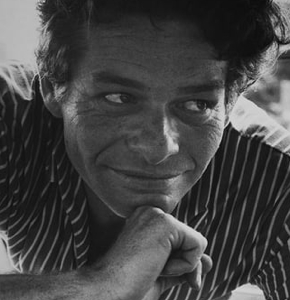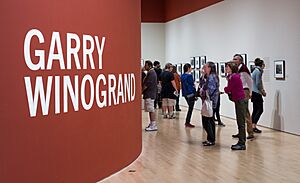Garry Winogrand facts for kids
Quick facts for kids
Garry Winogrand
|
|
|---|---|
 |
|
| Born | January 14, 1928 The Bronx, New York City, US
|
| Died | March 19, 1984 (aged 56) Tijuana, Mexico
|
| Occupation | Street photographer |
| Spouse(s) |
|
| Children | 3 |
Garry Winogrand (born January 14, 1928 – died March 19, 1984) was an American photographer. He was famous for his "street photography," which showed everyday life and social issues in the United States during the mid-1900s. A well-known photography expert, John Szarkowski, called Winogrand the most important photographer of his time.
Garry Winogrand received three special awards called Guggenheim Fellowships for his personal photo projects. He also got an award from the National Endowment for the Arts. During his life, he published four photography books. He was one of three photographers in a very important art show called New Documents at the Museum of Modern Art (MoMA) in New York in 1967. He also had his own shows there in 1969, 1977, and 1988.
To earn money, he worked as a freelance photojournalist and advertising photographer in the 1950s and 1960s. Later, in the 1970s, he taught photography. His pictures were featured in many photography magazines like Popular Photography and Eros.
Many critics praised his work. Sean O'Hagan, a journalist, wrote in 2014 that Winogrand "defined street photography" in the 1960s and 70s. He added that Winogrand's photos of New York were so important that they influenced many photographers who came after him. Phil Coomes from BBC News said in 2013 that Winogrand's pictures of New York in the 1960s were "a photographic lesson in every frame."
Winogrand published four main books: The Animals (1969), Women are Beautiful (1975), Public Relations (1977), and Stock Photographs: The Fort Worth Fat Stock Show and Rodeo (1980). When he passed away, he had a huge amount of undeveloped film. This included about 2,500 rolls that were not yet developed, 6,500 rolls that were developed but not yet looked at closely, and about 3,000 rolls that had only been made into contact sheets.
Contents
Early Life and Learning
Garry Winogrand's parents, Abraham and Bertha, came to the U.S. from Hungary and Poland. Garry grew up with his sister Stella in a working-class area of the Bronx, New York. This neighborhood had many Jewish families. His father worked with leather in the clothing industry, and his mother made neckties at home.
Winogrand finished high school in 1946. After that, he joined the U.S. Army Air Force. He came back to New York in 1947. He studied painting at City College of New York and both painting and photography at Columbia University in 1948. In 1951, he also took a photojournalism class taught by Alexey Brodovitch at The New School for Social Research in New York.
Photography Career
Winogrand worked as a freelance photojournalist and advertising photographer during the 1950s and 1960s. From 1952 to 1954, he worked for the PIX Publishing agency in Manhattan. He started there with help from Ed Feingersh. After 1954, he worked with Brackman Associates.
One of Winogrand's famous photos, showing a man lifting a woman playfully at the beach, was part of The Family of Man exhibition in 1955. This show was at the Museum of Modern Art (MoMA) in New York. It then traveled around the world and was seen by 9 million people. His first solo photo show was in 1959 at Image Gallery in New York. His first important group exhibition was Five Unrelated Photographers in 1963, also at MoMA. He showed his work alongside photographers like Minor White and Jerome Liebling.
In the 1960s, Winogrand took many photos in New York City. Other famous photographers like Lee Friedlander and Diane Arbus were also taking pictures there at the same time.
In 1964, Winogrand received a Guggenheim Fellowship. This award helped him travel to take "photographic studies of American life."
In 1966, his work was shown at the George Eastman Museum in Rochester, New York. This exhibition was called Toward a Social Landscape. In 1967, his photos were included in the very important New Documents show at MoMA. He was featured with Diane Arbus and Lee Friedlander in this exhibition.
His first book, The Animals (1969), featured photos he took at the Bronx Zoo and the Coney Island Aquarium. This book looked at the connections between people and animals. He often took these photos when he visited the zoo with his young children after his divorce.
He received his second Guggenheim Fellowship in 1969. This time, he explored how the media affected events. He photographed public events between 1969 and 1976. He produced 6,500 prints for his solo exhibition at MoMA and his book, Public Relations (1977).
In 1975, Winogrand published Women Are Beautiful. This book showed his interest in the female form. Some critics did not like the book. One critic said that many of his photos of women seemed to be taken without them knowing. This made the images feel awkward.
In the 1970s, he supported himself by teaching photography. He taught in New York first. Then, he moved to Chicago in 1971 and taught at the IIT Institute of Design until 1972. In 1973, he moved to Texas and taught at the University of Texas at Austin until 1978. He then moved to Los Angeles in 1978.
In 1979, he used his third Guggenheim Fellowship to travel across the southern and western United States. He took photos to explore social issues of that time.
His book Stock Photographs (1980) showed "people in relation to each other and to their show animals" at the Fort Worth Fat Stock Show and Rodeo.
John Szarkowski, who was the Director of Photography at MoMA, helped edit and review Winogrand's work.
Personal Life
Garry Winogrand married Adrienne Lubeau in 1952. They had two children, Laurie (born 1956) and Ethan (born 1958). They separated in 1963 and divorced in 1966.
Around 1967, Winogrand married his second wife, Judy Teller. They were together until 1969.
In 1972, he married Eileen Adele Hale. They had a daughter named Melissa. They stayed married until his death in 1984.
Death and Legacy
Garry Winogrand was diagnosed with gallbladder cancer on February 1, 1984. He passed away on March 19, 1984, at the age of 56. He was buried at Mount Moriah Cemetery in Fairview, New Jersey.
When he died, a lot of his later work was still unfinished. He left behind almost 300,000 unedited photos. This included about 2,500 rolls of undeveloped film and many more that had been developed but not yet fully reviewed.
The Garry Winogrand Archive is at the Center for Creative Photography (CCP). It holds over 20,000 prints, 20,000 contact sheets, 100,000 negatives, and 30,500 color slides. It also has some Polaroid prints and a few amateur films. Some of his undeveloped work was shown after his death in an exhibition and book called Winogrand, Figments from the Real World (2003).
More of his early and late work, along with his well-known photos, were part of a traveling exhibition that started in 2013. A book called Garry Winogrand (2013) was also published with this show. Photographer Leo Rubinfien organized the 2013 exhibition. He wanted to find out if Szarkowski was right about Winogrand's later work. Szarkowski believed Winogrand's best work was done by the early 1970s. Rubinfien later thought Winogrand's best period was from 1960 to 1964.
All of Winogrand's wives and children attended a special exhibit of his work at the San Francisco Art Museum after he passed away.
Many people remember Garry Winogrand for his unique style. John Szarkowski called him the most important photographer of his generation. Frank Van Riper from the Washington Post described him as "one of the greatest documentary photographers of his era." Sean O'Hagan wrote that Winogrand "defined street photography" in the 1960s and 70s. He said Winogrand's photos of New York were very important. Phil Coomes of BBC News said that Winogrand's pictures of New York in the 1960s are like a "photographic lesson in every frame."
Exhibitions
Solo Exhibitions
- 1969: The Animals, Museum of Modern Art, New York.
- 1972: Light Gallery, New York.
- 1975: Women are Beautiful, Light Gallery, New York.
- 1977: Light Gallery, New York.
- 1977: The Cronin Gallery, Houston.
- 1977: Public Relations, Museum of Modern Art, New York.
- 1979: The Rodeo, Allan Frumkin Gallery, Chicago.
- 1979: Greece, Light Gallery, New York.
- 1980: University of Colorado Boulder.
- 1980: Garry Winogrand: Retrospective, Fraenkel Gallery, San Francisco.
- 1980: Galerie de Photographie, Bibliothèque nationale de France, Paris.
- 1981: The Burton Gallery of Photographic Art, Toronto.
- 1981: Light Gallery, New York.
- 1983: Big Shots, Photographs of Celebrities, 1960–80, Fraenkel Gallery, San Francisco.
- 1984: Garry Winogrand: A Celebration, Light Gallery, New York.
- 1984: Women are Beautiful, Zabriskie Gallery, New York.
- 1984: Recent Works, Houston Center for Photography, Texas.
- 1985: Williams College Museum of Art, Williamstown, Massachusetts.
- 1986: Twenty Seven Little Known Photographs by Garry Winogrand, Fraenkel Gallery, San Francisco.
- 1988: Garry Winogrand, Museum of Modern Art. Retrospective.
- 2001: Winogrand's Street Theater, Rencontres d'Arles festival, Arles, France.
- 2013/2014: Garry Winogrand, San Francisco Museum of Modern Art, San Francisco, March–June 2013 and toured; National Gallery of Art, Washington, D.C., March–June 2014; Metropolitan Museum of Art, New York, June–September 2014; Galerie nationale du Jeu de Paume, Paris, October 2014 – February 2015.
- 2019: Garry Winogrand: Color, Brooklyn Museum, Brooklyn, NY, May–December 2019.
Group Exhibitions
- 1955: The Family of Man, The Museum of Modern Art, New York.
- 1957: Seventy Photographers Look at New York, The Museum of Modern Art, New York.
- 1963: Photography '63, George Eastman House, Rochester, New York.
- 1964: The Photographer's Eye, Museum of Modern Art, New York. Curated by John Szarkowski.
- 1966: Toward a Social Landscape, George Eastman House, Rochester, NY. Photographs by Winogrand, Bruce Davidson, Lee Friedlander, Danny Lyon, and Duane Michals. Curated by Nathan Lyons.
- 1967: New Documents, Museum of Modern Art, New York with Diane Arbus and Lee Friedlander, curated by John Szarkowski.
- 1969: New Photography USA, Traveling exhibition prepared for the International Program of Museum of Modern Art, New York.
- 1970: The Descriptive Tradition: Seven Photographers, Boston University, Massachusetts.
- 1971: Seen in Passing, Latent Image Gallery, Houston.
- 1975: 14 American Photographers, Baltimore Museum of Art, Maryland.
- 1976: The Great American Rodeo, Fort Worth Art Museum, Texas.
- 1978: Mirrors and Windows: American Photography since 1960, Museum of Modern Art, New York.
- 1981: Garry Winogrand, Larry Clark and Arthur Tress, G. Ray Hawkins Gallery, Los Angeles.
- 1981: Bruce Davidson and Garry Winogrand, Moderna Museet / Fotografiska, Stockholm, Sweden.
- 1981: Central Park Photographs: Lee Friedlander, Tod Papageorge and Garry Winogrand, The Dairy in Central Park, New York, 1980.
- 1983: Masters of the Street: Henri Cartier-Bresson, Josef Koudelka, Robert Frank and Garry Winogrand, University Gallery, University of Massachusetts Amherst.
Collections
Winogrand's work can be found in these public art collections:
- Art Institute of Chicago, Chicago, IL
- George Eastman Museum, Rochester, NY
- Museum of Modern Art, New York
- Whitney Museum of American Art, New York
Awards
- 1964, 1969, 1979: Guggenheim Fellowship from the John Simon Guggenheim Memorial Foundation
- 1975: Fellowship from the National Endowment for the Arts
Films
- Garry Winogrand: All Things Are Photographable (2018) – a documentary film by Sasha Waters Freyer
See also
 In Spanish: Garry Winogrand para niños
In Spanish: Garry Winogrand para niños


